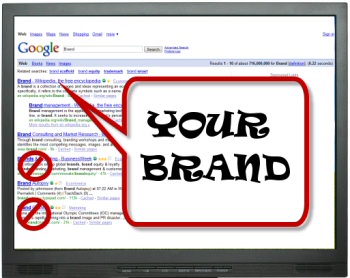Companies large and small spend significant proportions of their revenue on branding efforts as well as those things that influence customer perception of brand like product development, support and customer service.
While there is debate about who “owns” a brand, the company or it’s customers, partners and employees, it can be agreed that there is tremendous value and equity in a company’s brand. Something of value is worth protecting especially when it contributes to the livelihood of all the employees of the company and their families.
In the past week I’ve presented on online reputation management both for Public Relations and and Direct Marketing audiences and it’s reminded me of how important it is to protect a brand whether it’s new or established.
Not long ago I came accross a few web sites using the same and similar names to our own trademarked name. Upon contacting one company, it turned out they were no longer a company and ended up selling the domain name to us – a mutually beneficial outcome.
Another situation proved to be a bit more concerning. The same individual had multiple versions of the same site on different urls, some redirecting with 302. Some were on domain names and others were domain names pointing to a frame with the actual site was hosted on a third party domain. With the cheap price of hosting these days, who does that anymore?
Many of the pages used keyword stuffing and it was obviously a network of sites to promote a SEO consulting practice as well as promotion of their clients.
Maybe it was not exactly against search engines terms of use and webmaster guidelines, but it was/is certainly very sloppy and unprofessional. These pages/sites use multiple identities including a name very similar or exactly like our own.
What impression would a prospective client get when Googling your company and finding sloppy, near spammy web pages from some other company/individual that include references to your trademarked brand name?
It’s concerning enough that a name very similar to our trademark was being used but the use was inconsistent and in a way that hardly contributed to the brand of those promoting it, let alone our own. A company’s brand and trademark(s) are worth protecting for the sake of employees, clients, prospective clients and the future of the company.
To enforce trademark use at large like some big companies do is one thing, but to protect the brand experience of your potential customers in a situation so sloppy like the one above is reasonable by all definitions.
In our case, we contacted the subject individually for a reasonable outcome without success. The follow up was done via attorney which has made some progress towards removing trademark references. We continue to monitor and will address each situation individually.
It’s important that any company that is investing in it’s brand make the effort to monitor their company, brand, product and executive names online. Free services like Google Alerts and RSS feeds of search results are a good start for collecting raw data. For advanced analysis and measures of influence and sentiment, premium tools like Radian6, BuzzLogic, Collective Intellect, Cymfony and Converseon are the next step.
As for the situation described above, I am not listing this company/consultant or linking to the numerous live and archived examples we’ve taken screen shots of because I have no interest in further promoting them or having them benefit from all the work TopRank puts into promoting the search marketing industry via speaking, blogging and publishing articles.
What I am interested in is hearing from our valued Online Marketing Blog readers about copyright, brand protection and trademark enforcement situations experienced online. What situations can you share that describe others’ use of your branded names and what did you do about it?



